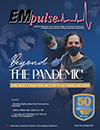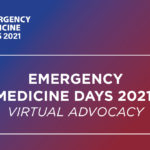Until the Monitor Alarms: Pain, Death and COVID-19
“Mom, when can we go see Grandpa?”
The truth was that Mom did not know. How could she tell Johnny that his grandpa’s heart was not functioning well, his lungs were filling with fluid, that he did not recognize his own children, let alone his grandchildren? Johnny idolizes his grandfather.
“Soon, Johnny, soon.” She knows it is a lie as soon as the words leave her lips.
The novel coronavirus of 2019 (COVID-19) outbreak has made life difficult for many, but it has become more difficult for a small subset of the population that many do not regularly acknowledge, hospice and end of life (EOL) patients, because of the restrictions in place. COVID-19 has brought with it a myriad of logistical, medical and emotional hurdles to patients at the EOL. They are suffering and dying alone. Physicians have developed many ways to define and classify pain, and a patient’s and family’s experience with EOL certainly qualifies. It is often difficult for many physicians to address pain in the EOL because it can feel like we are giving up and surrendering our charge to the Grim Reaper, who many physicians and nurses consider the enemy.
Logistically, the healthcare team cannot take care of EOL patients in the same manner as expected due to the difficulty in accessing personal protective equipment (PPE) and the delay associated with donning and doffing the PPE appropriately. Families have been asked to limit their physical presence with EOL patients for fear of spreading COVID-19, and as such have been less involved. They cannot provide immediate emotional, spiritual or religious support for their loved ones. Video chats, FaceTime and virtual applications have been employed by healthcare teams to give families access to their loved ones, but these workarounds cannot replace a bedside vigil where family members surround the patient as they pass. With these limitations, it has made EOL care more difficult for patients. Johnny’s last interaction with his grandpa would be artificial and would not ease either party’s pain or give them closure.
Medically speaking, if the patient is awake, alert and oriented, then what options are available? Traditionally, these patients were treated symptomatically and occasionally sedated with medication when their pain became overwhelming. This of course brings into question the types of dying that may require management, i.e. palliation. [1] In the post-COVID age, whether or not clinicians should be more liberal with sedation or pain management is an open question. Since EOL patients have less access to the physical presence of their caretakers/loved ones, there is a dilemma, because while sedating them might relieve their physical suffering, the agents we use might close the window for them to be able to speak with their loved ones. When we are isolated and alone, particularly at the end of our lives, this can cause significant emotional distress and pain.
Clinicians must balance these types of pain. If EOL patients do not wish to be sedated but are still uncomfortable, pain management options should be considered. Certain guidelines have been suggested by various institutions given the omnipresence of COVID-19. These multimodal options include physical manipulations, opioids and benzodiazepines, [2,3] although more research is needed. [4] Treating grandpa’s agonizing air hunger upon his final breaths should be considered with or without Johnny’s virtual or physical presence.
At the same time, emotional considerations cannot be ignored. The EOL patient will likely be more lonely, depressed, agitated or anxious, especially if the patient is unable to have physical visitors during the COVID-19 era. Virtual presence can be helpful, but is not a replacement for physical presence. In addition, the emotional well-being of friends and family of the EOL patient should be considered as well. During this era, it will be more difficult to know that their EOL patient cannot have the appropriate/necessary visitation during EOL care. Furthermore, doctor/family meetings cannot take place as usual. How does a clinician keep friends and family apprised of the significant events of grandpa? How does one inform them of grandpa’s imminent demise?
Ultimately, a viral pandemic has made life difficult, but EOL patients and those associated with them cannot be forgotten. Johnny won’t ever hear his grandfather’s stories again while they sit together on a park bench. Johnny won’t have his grandfather at his high school graduation or wedding. And now, Johnny won’t even be with his grandfather as he takes his final breath. Grandpa will likely die alone in his hospital bed, and even the nurses and doctors may not know of his passing until the monitor’s alarm.
Stress is omnipresent, especially during these unprecedented times. It is imperative to remain cognizant of all the stressors and collaborate accordingly with EOL care patients, friends, family and staff. ■
References
- Turner J, Eliot hodgson L, Leckie T, Eade L, Ford-dunn S. A Dual-Center Observational Review of Hospital-Based Palliative Care in Patients Dying With COVID-19. J Pain Symptom Manage. 2020;60(2):e75-e78.
- Managing COVID-19 symptoms (including at the end of life) in the community: summary of NICE guidelines. BMJ. 2020;369:m1461.
- Sun H, Lee J, Meyer BJ, et al. Characteristics and Palliative Care Needs of COVID-19 Patients Receiving Comfort-Directed Care. J Am Geriatr Soc. 2020;68(6):1162-1164.
- Lovell N, Maddocks M, Etkind SN, et al. Characteristics, Symptom Management, and Outcomes of 101 Patients With COVID-19 Referred for Hospital Palliative Care. J Pain Symptom Manage. 2020;60(1):e77-e81.
This article is part of the following sections:
Samantha manages fcep.org and publishes all content. Some articles may not be written by her. If you have questions about authorship or find an error, please email her directly.







